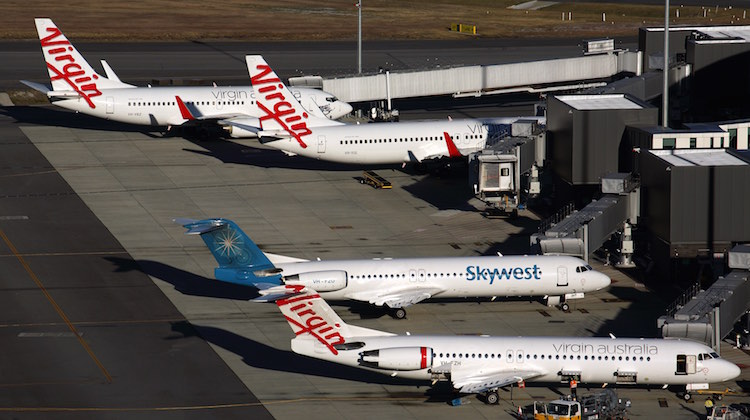
Virgin Australia has reported a drop in profit for the three months to December 31 2016 as weak market conditions hit revenues, prompting the airline group to operate fewer domestic flights.
The company said statutory profit after tax for the second quarter of the 2016/17 financial year came in at $13.1 million, compared with $60.8 million in the prior corresponding period.
Virgin said on Friday the statutory result included the impact of restructuring charges related to its ‘Better Business program’ announced in 2016. However, Virgin did not put a dollar figure on the extent of the one-off charge.
Underlying profit before tax, which removes one-off charges and is regarded as the best indicator of financial performance, fell 37 per cent in the second quarter to $45.9 million, from $73 million a year earlier.
“Subdued industry trading conditions in the domestic market continued to adversely impact revenue during the second quarter,” Virgin said in a statement to the Australian Securities Exchange (ASX).
“The group continues to actively manage capacity in response to subdued trading conditions.”
An analysis of Virgin’s 2016/17 first and second quarter results showed the airline group achieved a statutory profit after tax of $20.7 million for the first half of the current financial year. The result was down 70 per cent from $69.3 million in the 2015/16 first half.
Meanwhile, Virgin’s 2016/17 first half underlying profit before tax was $42.3 million, a decline of 48 per cent from $81.5 million achieved in the 2015/16 first half.
The company said the total sectors flown on Virgin Australia’s domestic network was down five per cent in the second quarter.
While capacity, measured by available seat kilometres (ASK) rose 1.6 per cent in the quarter, Virgin said this was “primarily driven” by an increase in widebody Airbus A330-200 flights compared with the second quarter of 2015/16, when a number of aircraft were temporarily taken out of service to have a new business class cabin installed.
Further, the progressive withdrawal of Virgin’s Embraer E190 fleet has meant some routes previously served by the 98-seat aircraft have been upgauged to “larger aircraft”, mostly the 176-seat Boeing 737-800.
“The group expects the Virgin Australia domestic business to generate an underlying earnings before interest and tax margin of between three and six per cent for the 2017 financial year,” Virgin said.
Virgin Australia’s international network reported an 8.1 per cent reduction in ASKs. The airline handed over flights to Bali from Adelaide, Melbourne and Perth to its low-cost unit Tigerair Australia in March 2016, which explains the reduction in capacity and a 7.1 per cent fall in passenger numbers.
Meanwhile, Tigerair continued to post double-digit growth.
The low-cost carrier, which has 14 Airbus A320s and four 737-800s in its fleet, grew domestic and international ASKs 24.7 per cent in the second quarter.
As previously mentioned, Tigerair started international flights to Bali (which have been suspended due to regulatory issues with Indonesia) in March 2016.
However, the growth in available seats was more than matched by market demand, with Tigerair increasing revenue passenger kilometres (RPK) 28.9 per cent in the quarter. As a result, load factors rose 2.8 percentage points to 89.3 per cent across its domestic and international network.
Virgin said it had strengthened its balance sheet in the second quarter through a reduction in net debt and an increase in its total cash balance.
Virgin said the closing total cash balance of $1.6 billion at December 31 was the highest ever reported total cash balance for the airline group.
The airline group raised about $1.1 billion from shareholders in 2016 thanks to a share placement new investor HNA, as well as a capital raising through the issuing of new shares.
“The group delivered positive outcomes in its liquidity and leverage as a result of the program of work that was initiated under the group’s capital structure review in the 2016 financial year,” Virgin said.










